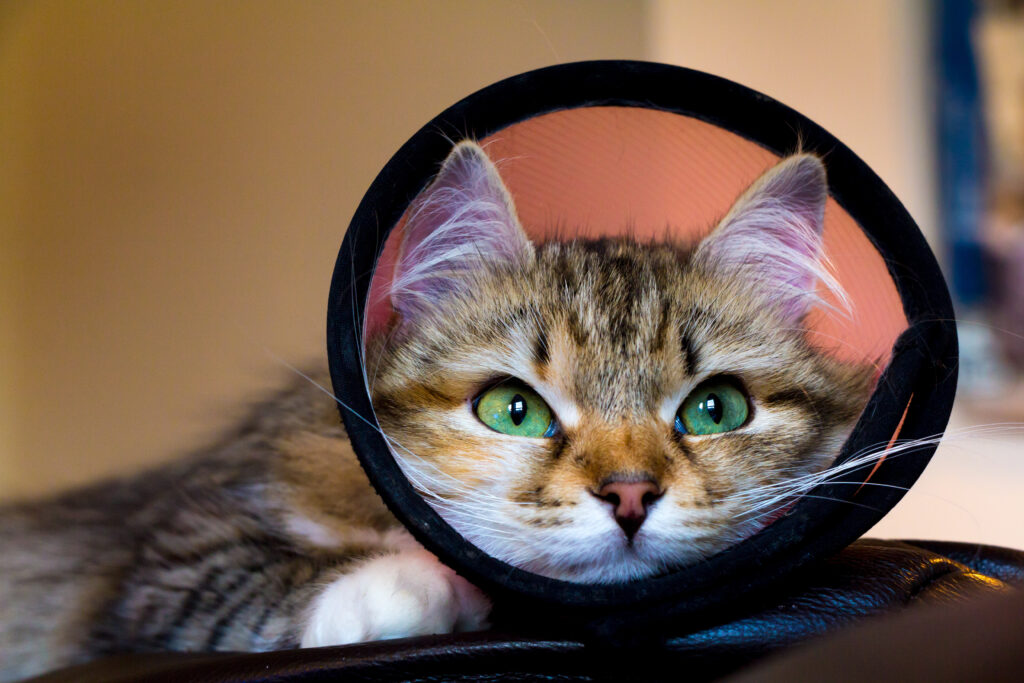Key Points
- Spaying and neutering are common surgical procedures that can benefit your cat’s long-term health and behavior.
- Veterinarians recommend spaying or neutering your cat when they’re around 5 months old, but the procedure is safe older cats, too.
- Joining the Pumpkin Wellness Club* gives you the option to get up to $150 in cash for your cat’s spay or neuter procedure, plus more for routine care like vaccinations, wellness exams, and blood work.
Did you know that a female cat can give birth to up to 100 kittens in her lifetime? It’s true: Girl cats can get pregnant for the first time at just 4 months of age, and they usually go into heat two to three times per breeding season.
You might think that, with this biological blueprint, your feline companion is meant to be a mother. However, mating and pregnancy come with avoidable risks, and there’s a simple way to eliminate them. Spaying your cat can help prevent certain diseases and undesirable behaviors, with the added benefit of curbing overpopulation in shelters and on the street. And don’t forget about neutering male cats — it takes two to tango, and you’ll be glad that your tomcat isn’t roaming around late at night.
If you’re welcoming a new cat into your home, you might be wondering when to bring them to the vet for a spay or neuter procedure. Pumpkin is here to walk you through all things spay- and neuter-related, from the benefits and common misconceptions about the procedure to the best time to get started.
What is spay/neuter surgery?
Neutering is the sterilization of male animals, while spaying is the sterilization of female animals. The procedure involves removing the reproductive organs (the testicles in males, or the uterus and ovaries in females) in a minimally invasive surgery.
Sterilization might sound like a scary word, but consider that your cat can’t choose to practice safe sex. Without these procedures, the population of stray cats and kittens would increase beyond the capacity of shelters and potential adopters. Spaying and neutering means fewer cats on the street, lower rates of euthanasia in shelters, and less transmission of illness among stray cat populations.
Pet Pro Tip: Join the Pumpkin Wellness Club to save up to $390/year on key preventive care services that help keep cats healthy, plus access to discounts on top pet products. Learn more about membership options and how you can get paid for your kitty’s spay or neuter procedure.
When is the best time to spay or neuter your cat?

Contrary to popular belief, there’s no known benefit to waiting to spay a female cat (or dog) before her first heat cycle. Kittens may be cute, but remember that each litter of three to six little ones will need appropriate veterinary care and forever homes — in the long run, spaying or neutering a single cat is less expensive for you and better for your pet’s health.
The sweet spot for spaying or neutering cats is 5 months of age or earlier, or before the first heat cycle, according to the American Veterinary Medical Association. At this young age, your kitten is likely to bounce back quickly from surgery — and cat owners will be happy to learn that “fixed” cats are less likely to engage in fights and urine marking.
Typically, you would make the decision to spay or neuter your cat early on in their life (usually after 6-8 weeks). But provided your cat is healthy, they can safely undergo a spay or neuter procedure at a later date, depending on how old your cat is when they settle into their forever home.
What are the benefits of spaying or neutering a cat?
Now that you have a better idea about when your cat should be sterilized, let’s consider how they can benefit from the procedure. The AVMA recommends spaying or neutering your cat not only to prevent unwanted litters, but also to decrease the risk of certain cancers and discourage undesirable behaviors.
Spaying prevents heat cycles, which can occur multiple times in a breeding season. This means your cat won’t go through the hormonal changes associated with going into heat — and your household can avoid the yowling, crying, and other erratic behavior that typically comes with it.

Spaying your female cat also decreases their risk of developing cancers and infections of the uterus and ovaries, according to the Merck Veterinary Manual. Cats can face a life-threatening uterine infection called pyometra if they are left sexually intact, and there’s also the possibility of complications during pregnancy and birth.
For male cats, the benefits of neutering are mainly behavioral. Neutering your male cat will reduce behaviors such as urine spraying, roaming outside in search of a mate, and fighting with other males. An added bonus of eliminating the sexual organs is that you cut out the risk of your cat developing testicular tumors, but those tend to be benign.
How does spaying and neutering help other pets?
Another important reason why spay and neuter services exist is to help limit pet overpopulation. Experts estimate that between 60 and 100 million homeless and feral cats live in the United States, and all of them need food, water, and shelter to keep them safe from harm. Unfortunately, there’s not enough room for all of these cats in animal shelters.
Each year, nearly one million animals are euthanized in shelters across the country, and many more end up living and reproducing on the streets, further adding to overpopulation. The best way to do your part in preventing this cycle is to spay or neuter your cat, which will reduce the number of pets giving birth and free up forever homes for cats in need.
Common misconceptions about cat spaying and neutering
Some people believe that sterilizing your cat can cause them to gain weight, but the reality is that your cat will only gain weight if they’re overfed or don’t exercise often. As long as you continue to provide opportunities for your cat to exercise and monitor their food intake, your pet will remain fit. Many animals stay active for years to come after their spay or neuter surgery, so you can rest assured that your furry companion won’t lose their zest for life along with their gonads.
Another myth about spaying and neutering is that it’s a guaranteed fix for all behavioral problems. This isn’t true either — while your cat’s sexually-driven behaviors will likely improve after the procedure, there’s no guarantee that their behavior will change drastically or that all of their harmful habits will go away. Be sure to consider other possible reasons for undesirable behaviors, like trouble at the litter box or separation anxiety.
What are the typical costs to spay or neuter your cat?
The cost of spay and neuter services for cats depends on several factors: your cat’s age, where you live, and where you go for the procedure, just to name a few. Taking your cat to a private veterinary practice is more expensive than going to a non-profit spay/neuter clinic, but sticking with your regular vet also comes with some benefits.
At a private vet appointment, the technician will typically draw blood from your cat prior to the spay or neuter procedure to ensure that anesthesia is safe for them. With bloodwork and anesthesia included, a spay package can cost $400 or more, while a neuter package costs around $300 (it’s a less complicated procedure). A priceless bonus is that your vet is likely familiar with your cat’s quirks and can prescribe post-operative pain medication if it’s needed.
Tip: One factor that could affect the price of a female cat’s spay is whether or not she’s currently in heat or pregnant, as this becomes a more complicated, high-cost procedure.
Another way to save on spay/neuter costs is to enroll in a wellness program or plan that pays you for your pet’s routine preventive care, like the Pumpkin Wellness Club. One membership option offers pet parents up to $150 in cash for the spay/neuter procedure. What’s more, members can also get paid for essential vaccinations, annual wellness exams, routine blood work, and more — so even after your cat is ‘fixed,’ there is plenty more cash back to be had.
Your pet’s surgeon will be sure to discuss the risks and benefits of spaying and neutering so you can squelch any worries before the procedure. And remember: the cost of spaying or neutering your cat is far less than the cost of having to care for a litter, or the cost of potential health problems that can occur without the procedure.
More tips for your cat’s spay and neuter recovery

Most vets ask that your cat not eat or drink for up to 12 hours before surgery to reduce the likelihood of vomiting during the procedure. If your cat goes outdoors or isn’t a fan of their cat carrier, consider keeping them indoors so you can easily collect them before the surgery.
A cat spay is generally 30 minutes to an hour, depending on her age and where she is in her heat cycle, while an uncomplicated cat neuter can be done in under five minutes. Cryptorchid cat neuters — where one or both of the testicles is undescended — will take longer and may cost more.
Surgery hurts, so don’t hesitate to ask for pain medication to be sent home with your cat. Be prepared to monitor your furry friend closely several days after the surgery, and be sure to do the following to help with your cat’s recovery:
- Provide your cat with a quiet place to recover indoors and away from other animals.
- Prevent your cat from running and jumping for up to two weeks following surgery.
- Prevent your cat from licking the incision site, which may cause infection. A cone may be placed on their head to prevent licking.
- Give all pain medications as prescribed, even if your cat seems ‘fine.’
- Avoid bathing your pet for at least 14 days after surgery.
- Check the incision site daily to confirm proper healing. If you notice redness, swelling, odor, or discharge, call your vet.
- Watch for fever and other signs of illness.
What’s the first step in spaying or neutering your cat?
If you’ve decided to spay or neuter your cat, contact your vet to set up a spay/neuter appointment. Be sure to discuss the procedure in detail so you know what to expect. And before you get started, learn more about the Pumpkin Wellness Club, a new way to get cash back and save on your pet’s routine preventive care.
DISCLOSURE





